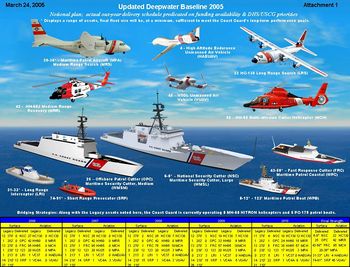Project Deepwater
Project Deepwater was an ambitious plan to upgrade the capabilities of the United States Coast Guard following al-Qaeda's attacks in the Continental USA on September 11th, 2001.[1][2][3][4][5] A consortium of Aerospace companies Lockheed Martin and Northrop Grumman were originally the "lead systems integrator". The consortium of the two companies originally enjoyed a controversial amount of authority overseeing subcontractors. Several of the subprojects the consortium oversaw went overbudget, were delayed, or were total failures. In 2007 Thad Allen, then the Commandant of the Coast Guard, announced that the Coast Guard would take over direct management of all the projects.
Refit to extend the Island class cutters
The USCG Island class cutters were required a mid-life refit. The refit was to add capabilities, as a stop-gap, until more modern vessels like the Fast Response Cutter was ready. Eight of the 57 vessels of the class were extended, to add a stern launching ramp. Their refit went over-budget, was delayed, and, when the extended vessels were relaunched, they were found to be fundamentally unsafe.
Fast Response Cutter -- version A
The replacement for the Island class cutters was to be the Fast Response cutter, which was to be built incorporating novel materials, like a composite hull. In 2007 Allen announced that the original design would be abandoned, and an alternate design, Fast Response Cutter -- version B, would be built instead. The alternate design would focus on proven, "off the shelf" technology. The alternate design had a steel hull, and aluminium superstructure. Its design was a modification of a proven design licensed from the Dutch shipbuilding consortium the Damen Group.
References
- ↑ Coast Guard electronics upgrade program kicks into high gear, Militaryaerospace.com, 2003. Retrieved on 2011-05-24.
- ↑ Thad Allen. STATEMENT BY ADM. THAD ALLEN on the converted 123-foot patrol boats and changes to the Deepwater acquisition program, United States Coast Guard, 2007-04-17. Retrieved on 2008-06-26. mirror
- ↑ Jason Miller. Justice Department investigating Deepwater for possible fraud, Federal Computer Week, 2007-04-18. Retrieved on 2008-06-26.
- ↑ Renae Merle, Spencer Hsu. Coast Guard To Take Over 'Deepwater': Move Wrests Control From Consortium of Contractors, Washington Post, 2007-04-17, p. D01. Retrieved on 2008-06-01. mirror
- ↑ US Coast Guard Taking Over Lead Role for Deepwater Program, Defense Industry Daily, 2007-04-18. Retrieved on 2008-06-26. mirror
